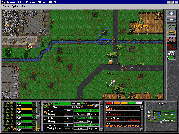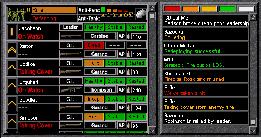


This is top-down overhead perspective real-time squad-level wargaming. Originally called Beyond Squad Leader, when the company was associated with Avalon Hill in Baltimore Maryland, now called Close Combat when the publisher switched to Microsoft. And perhaps now that the company has gone with Microsoft some of the grognard bitching about the purity of the product, when compared to game classic Squad Leader, will die out.
Take the role of the US 29th Infantry Division or the German 352nd Infantry Division along the 20 miles of hedgerow and countryside from Omaha Beach to St. Lo. There are three scenarios: boot camp, maneuvers, and the one campaign. Boot camp mode is training. Maneuvers is actually individual missions played without the campaign. The campaign strings the maneuvers missions together and tracks your career through all the missions therein.
A large map window is seen in the upper portion of the screen with a command bar on the right and a set of status panels at the bottom. These monitors keep track of the units, their statistics, and a larger overhead map view in the lower right corner. Difficulty can be set by using one of three levels, including easy, normal, and hard, or by setting a number of statistics on enemy and allied troops.
Control extends right down to the individual soldier level, with
multiple statistics on each man. The game supports resolutions of up to
800x600, and will zoom in or zoom out on the main overhead map display.
The real-time aspect of play, like Command and Conquer, results in
awkward commands from the human player who is controlling too many men,
especially when the scrolling and other computer functions are being
bogged down by the considerable data crunching it takes to model each
soldier and bullet individually. Scrolling is slow and distracts play
when it jerks around.

Individual soldiers can win one of six medals, five statistics are maintained on each man. Replacements of green troops occur between battles. Commands include move, move fast, fire, smoke, defend, and hide making this game one of the simplest command structures ever in a real war game.
There is no map, mission, or scenario editor which may turn some players off. The campaign and single missions are randomly generated on maps that change with time. The maps resemble those in Across the Rhine with small intricate details. Preferences allows you to set the pace of the game if things get too intense.
Artificial intelligence (AI) is very good, making quick decisions. When left to its own devices the AI can out play and out plan most human commanders, also like Across the Rhine.
Multi-player: A two player game can be played over internet or null and phone modem.
Review References:
www.ogr.com/reviews/close-combat.shtml 80%
Next Generation, volume 2, number , June, 1996, pg. 53.
www.cdmag.com/war_vault/close_combat/page1.html
Johnny L. Wilson, Computer Gaming World, number 143, June, 1996
Johnny L. Wilson, Computer Gaming World, number 143, June, 1996
P. Miller, Computer Gaming World, number 146, September, 1996, pg.33, warm (66%).
Steve Wartofsky, Computer Games Strategy Plus, issue 70, September, 1996, pg. 76-78.